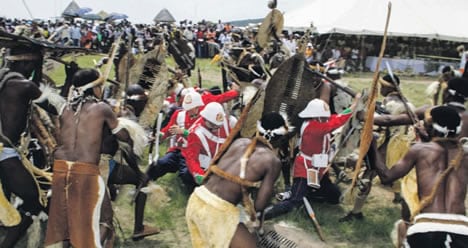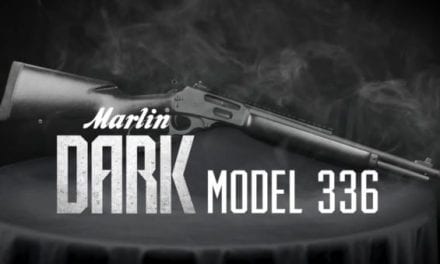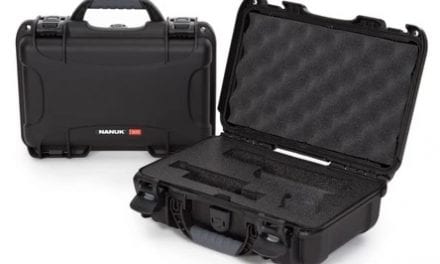by Charles R. Drago, Editor, OEL Magazine
As of the morning of January 22, 1879, the Martini Henry breach loading, single shot, lever-actuated rifle with which the British Army had been equipped was globally recognized as being what today we would describe as a “high tech” weapon of choice for then-modern European military forces.
As of the evening of January 22, 1879, arrogance and prejudice had rendered moot the quaint notion of “high tech.” More than 1,200 British soldiers of the 24th regiment as well as volunteers from the Natal province and Basotho auxiliaries, armed with the Martini Henry and in possession of ample supplies of ammunition, were utterly destroyed by an impi (army) of anywhere between 4,000 and 22,000 Zulu warriors armed in the main with throwing and slashing spears, clubs, and buffalo hide shields at the battle of Isandlwana in the province of KwaZulu-Natal, South Africa.
British Prime Minister Benjamin Disraeli would be left to ponder, “Who are these Zulus; who are these remarkable people who defeat our generals, convert our bishops, and who, on this day, have put an end to a great dynasty?”
For gun enthusiasts and, of course, collectors of historic firearms, brief technical descriptions of the Martini Henry and its bayonet and ammunition seem in order.
The rifle was 49 inches long, with a steel barrel 33.22 inches. The Henry patent rifling produced a heptagonal barrel with seven grooves with one turn in 22 inches. The weapon weighed 8 pounds 7 ounces. A sword bayonet was standard issue for noncommissioned officers; when fitted, the weapon extended to 68 inches and weight increased to 10 pounds 4 ounces.
The Mk2 Martini Henry rifle, as used in the Zulu Wars, was sighted to 1,800 yards. At 1,200 yards, 20 shots exhibited a mean deflection from the center of the group of 27 inches, while the highest point on the trajectory was 8 feet at 500 yards.
In the original chambering, the rifles fired a round-nosed, tapered-head .452-inch, soft hollow-based lead bullet, wrapped in a paper patch giving a wider diameter of .460 to .469 inches. It weighed 485 grains. It was crimped in place with two cannelures (grooves on the outside neck of the case), ahead of two fiber card disks, a concave beeswax wad, another card disk and cotton wool filler. This sat on top of the main powder charge inside initially a rimmed brass foil cartridge, later made in drawn brass.
The cartridge case was paper lined so as to prevent the chemical reaction between the black powder and the brass. It was charged with 85 grains of Curtis and Harvey’s No.6 coarse black powder, notorious for its heavy recoil. The cartridge case was ejected to the rear when the lever was operated.
The history of the Anglo-Zulu war – fought for the prize of South Africa – is not our primary concern. Rather, adrift on our own preconceived, underfed-by-fact conclusions, we seek an explanation for how a well-equipped European army could have perished at the hands of spear-carrying “natives.”
Superior numbers and superior generalship accruing to the Zulu impi led by the military strategist Ntshingwayo kaMahole surely stand as major contributing factors to the Zulu victory. So too the element of relative surprise – a factor fatally exacerbated by the unwillingness of Lord Chelmsford and Colonel Pulleine, commanders of the entire British invading force and the Isandlwana column respectively, to take defensive measures when establishing camp at the foot of the high outcrop which would lend its name to the coming battle.
The British were in possession of intelligence indicating that a large Zulu impi was in the general area. Over subsequent generations, objective military historians have reached the consensus that the failure of Pulleine to laager, or circle, his wagons in a defensive perimeter and instead deploy his troops in a semi-circular picket line some 300 yards from the camp all but guaranteed victory to a huge force charging the British position.
Gaps of 20 yards were left between each of the 600 pickets.
The Zulu attack came in the well-known “bull’s horn” formation. At the center (known as the chest in Zulu) were the most seasoned regiments; on the wings (or horns) were regiments comprised of younger warriors. The latter used their speed and agility to outflank the enemy by attacking on the flanks with the intent to encircle, while the chest warriors engaged from the front. Behind the chest, with their backs turned so as to keep their calm, were the veteran regiments (also known as the kidneys) who were utilized as reserves. Every man knew his place, moves, and maneuvers with extreme precision.
When the impi, in “bull’s horn” formation, approached, the British opened fire at roughly 250 yards. The Martini Henry could be fired between 12 and 15 times per minute. The Zulus covered the distance between forces in roughly 25 seconds.
The sheer speed of the Zulu advance overwhelmed and effectuated the slaughter of the picket line. A retreat to attempt a defense of the remaining soldiers in a virtually defenseless camp was futile. The classic British “square” in which three tiers of soldiers, shoulder-to-shoulder in kneeling, standing, and elevated postures could create an impenetrable curtain of firepower, could not be organized.
When, on the next day, basically the same impi attacked the former mission station at Rorke’s Drift on the Buffalo River, they ran headlong into intelligently constructed defensive positions organized by British Lieutenants Chard and Bromhead. A functioning “square” was deployed, denying the Zulus the opportunity to get within range to use their assegais, or spears.
What 1,200 men at Isandlwana could not accomplish, far fewer than 200 British troops pulled off at Rorke’s Drift. It was the Zulus’ turn to be slaughtered in a killing field beneath the barrels of Martini Henrys.
Since the moment news of the two engagements reached the British public, the power of myth began to color and ultimately obscure historical events. Americans can compare the process to the manners in which the Alamo and Little Bighorn have taken their fogged-in places in their national imagination.
In all of these instances, the fantasy of noble warfare should be shattered by ugly fact. In the immediate aftermath of the Rorke’s Drift engagement, British officers and enlisted men were dispatched to kill hundreds of wounded Zulu prisoners. There were hangings and bayonetings. Some Zulus were buried alive in mass graves.
One trooper, William James Clarke, reported, “Altogether, we buried 375 dead Zulus, and some wounded were thrown in the grave. Seeing the manner in which our wounded had been mutilated … we were very bitter and did not spare the wounded[.]”
And yet … At the end of the ‘60s film “Zulu”, narrator Richard Burton solemnly intones, “In the hundred years since the Victoria Cross was created for valor and extreme courage beyond that normally expected of a British soldier in the face of the enemy, only 1,344 have been awarded. Eleven of these were won by the defenders of the mission station at Rorke’s Drift, Natal, January 22nd to the 23rd, 1879.”
The battle of Isandlwana remains the single greatest defeat of the British army at the hands of a technologically inferior indigenous foe. The battle was a decisive victory for the Zulus and caused the defeat of the first British invasion of Zululand.
Today the fields at Isandlwana and Rorke’s Drift are national monuments visited by schoolchildren, historians, and tourists drawn to the romance that too often emerges from savagery and tragedy.

Martini Henry rifles said to have been used at Rorke’s Drift.

Examples of a Zulu spear, clubs, and shield.

A re-enactment of the Isandlwana fight, illustrating the overwhelming Zulu numbers and the ineffectiveness of the Martini Henry in close quarters. Note the spectators, protected from the sun and the deeper truth.
















